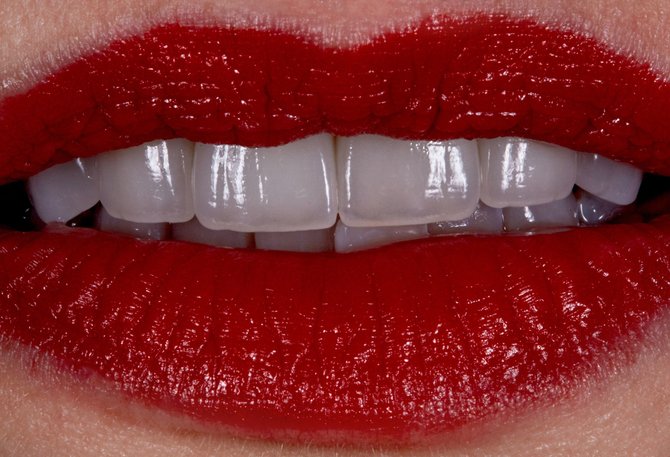Odontologist Jolita Ruginienė, who has been working at the Dantų Harmonija clinic for more than thirteen years, specialises in the field of aesthetic fillings and prosthetics and believes there are several factors playing into such changes on the market. Firstly is an increasingly modern and educated society, where people care more for their health and dedicate more time for daily oral hygiene and regular dentist visits.
Due to a more health-aware lifestyle, people face severe dental illnesses less often, allowing patients to invest in the aesthetics of their smiles. And according to the odontologist, an important role is also played by various style trends, with a beautiful smile now becoming an inseparable part of one’s image.
Differences between aesthetic fillings and ceramic laminates
“One of the most popular aesthetic dental services is teeth whitening, but those intent on improving their smiles even further seek aesthetic dental fillings and aesthetic dental prosthesis with ceramic laminate. However, an increasing amount of people choose ceramic laminates,” J. Ruginienė says.
The aesthetic fillings and prosthesis specialist points out several criteria for comparing these services: longevity, resilience, maintenance and price.
“While dental treatment with ceramic laminates is more expensive than fillings, most the decision is based on how after aesthetic dental fillings you have to perform professional oral hygiene and filling polishing every 6 months, and after 2-3 years, you need corrections, the fillings break off easier, change colour due to coffee or smoking.
“Also, in order to retain the shine of the fillings, you have to select specialist toothpaste without abrasives. However, no further maintenance is needed when wearing ceramic laminates – the strength of ceramics is a match for the natural strength of dental enamel, which means that regular oral hygiene rules suffice. After evaluating the time, maintenance and worry costs, most decide to choose laminates,” the Dantų Harmonija doctor explains.
Another important aspect is longevity. A professionally performed and correctly maintained aesthetic filling will serve 5-7 years, while ceramic laminates – up to 15 years and longer. Thus, the doctor advises choosing fillings when minimal dental corrections are needed, while a fundamental rework of your smile should be done with ceramic laminates.
Straight tooth line – evidence of lacking professionalism
Patients worry that such aesthetic procedures will irrevocably damage their natural teeth. However, odontologist Jolita Ruginienė says that when performing the work, a specialist in this area will not cause any harm to the teeth.
“Prior to performing both aesthetic fillings and applying prosthesis, only the damaged part of the enamel is to be polished – cracks, fissures and caries. The work must be performed with precision, under a magnifying glass. However, with poor quality tooth fillings, plaque will accumulate, food leftovers will linger between the teeth, and there can be frequent gingivitis or worse complications,” she says.
J. Ruginienė advises on what should be considered when selecting a professional odontologist.
“Firstly, the odontologist should specialise in one area to know it well and perform quality work. Secondly, you can always ask to see the work done by the doctor previously to evaluate it. When forming a smile, the priority is functionality, the natural purpose of the teeth – the bite. Thus, the teeth cannot be formed as a single straight line. In such a case, they will not perform their purpose appropriately, making even the ceramic laminate crack and break apart,” the doctor explains.
A brilliantly white smile isn’t suited for everyone
J. Ruginienė believes that often the future smile is imagined incorrectly. Many dream of especially white, smooth and large teeth, but in reality, this is not always suited for the individual.
“The smile should suit the face, accentuate its features, and the whiteness of the teeth should not be excessively noticeable. Every smile must be created individually, by its colour, form and proportions. At the Dantų Harmonija clinic, we offer patients a DSD service, which allows modelling the potential laminates so that the individual can actually try it out and see what results await them after treatment. This way, together with the patient, we can discuss the whiteness of their future smile, and the shape and proportions of their teeth so that they can enjoy their smile for many years into the future,” the specialist says.














